WikiProject Belgium/Conventions/Walking Routes
| WikiProject Belgium +/- | ||
| Conventions | ||
| Subprojects | ||
This page summarize some conventions for editing walking routes in OpenStreetMap in Belgium.
Mapping of walking and/or biking routes must be restricted to routes signposted by an official tourism agency that is assigning the node numbers, if any, and writing them to the signs.
In short, walking routes are mapped in OpenStreetMap relations of the type route=*.
Long distance walking routes (GR)

GR footpaths (Grote Routepaden [1] in Dutch or Grande Randonnée [2] in French) are signed with the usual red/white signs, and can also be found in large parts in western Europe.
Tagging examples (for relations):
| Tags | Description |
|---|---|
|
The GR 5 path, which runs from Bergen op Zooom in the Netherlands to Nice in France. | |
|
The GR AE path which runs from the Ardennes to the Eifel. |
RAVeL network
The RAVeL (Réseau Autonome de Voies Lentes) network stretches across Wallonia [3]. These routes are for walking, cycling, horse riding and skating. They're currently tagged as cycle routes (see here, but will need walking route tags as well once.
Walking node networks
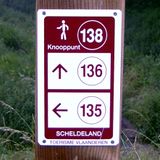
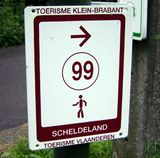
For detailed information on how to tag Walking node networks, see the extensive article on cycle networks, which to degree follow the same logic. Below, you'll only find a brief summary.
Since the cycle node networks were such a success, walking node networks also started appearing in some places. They work entirely the same as the cycle node networks, but only cover small areas.
A node is tagged like:
| Tags | Description |
|---|---|
|
|
A "35" node in the network. |
network:type=node_network
|
This defines the node as node network node. |
expected_rcn_route_relations
|
(optional) can be set to the number of relations ending/starting at this node (junction). This can be used to facilitate (automatic) checking for missing routes. Count only regular routes, route relations with state=connection or state=alternate are not counted towards the number of expected route relations.
|
The routes between the nodes are created with relations like:
| Tags | Description |
|---|---|
|
|
A route between two nodes. The "note" and "operator" keys are optional. Do not use the "ref" tags, they cause a rendering mess. |
When the routes follow different roads in both directions between two nodes, use the proper "forward" and "backward" roles for each relation member. See Relations/Routes for details.
Information on more complex tagging situation (for example two nodes with same node number) can be found on the dutch OSM forum
Local walking routes
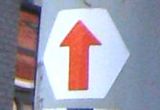
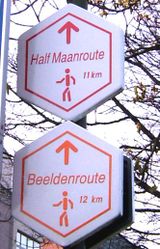
With local walking routes we generally mean all other walking routes, which usually make a loop back to its starting point, and can therefore be seen as the same type of route as the themed cycle routes.
Categorizing them may be hard, since every municipality seems to have their own way of signing. Furthermore some other organizations have also put signs all over Belgium. An overview of the local walking routes in Flanders can be found here and for Wallonia here.
Foot and hiking routes are walking routes, an established course of travel along a set of ways between destinations. They are often named, numbered or otherwise identifiable. A foot route is generally a shorter, easier route, often intended for leisure. A hiking route is generally longer and/or more strenuous and may require experience to be navigated safely.
Routes that are suitable for inclusion in OSM should usually match one or more of the following guidelines:
- The route is signed or otherwise identifiable on the ground.
- The route is established, documented and/or maintained by an organization that is well known or officially responsible for this function (e.g. mountaineering clubs, tourism boards, ...).
- The route itself is shared common knowledge among a significant number of people that are not all mutually connected. This usually means that it is easy to find different sources of information about it online or many people living in the area know about it. Examples for routes matching this criteria include the Haute Randonnée Pyrénéenne or the Greater Patagonia Trail, which are both unofficial and mostly unsigned, but are well known among long distance hikers.
If in doubt, suitability of a route for inclusion in OSM should be discussed with the relevant OSM community.
User contributed routes uploaded to trip planning and travel guide websites should typically not be added to OSM unless other criteria are met.
To tag a foot or hiking route you create a relation with the appropriate tags and add all different ways of the foot/hiking route to this relation. The order of the ways matters. Please see Relation:route#Order matters
Tags of the relation
| Key | Value | Explanation |
|---|---|---|
| Required | ||
type |
route
|
This relation represents a route. |
route |
hiking
|
route=foot is used for routes which are walkable without any limitations regarding fitness, equipment or weather conditions. As a guideline, you could say that ordinary shoes or trainers (at a pinch, even flip-flops) are adequate for this type of walking trail.
Don't use route=pilgrimage (almost non-existent). Instead, add pilgrimage=yes to a hiking-route. |
| Recommended | ||
network |
iwn
|
International walking network: long distance paths that cross several countries
National walking network: used for walking routes that are nationally significant and long distance paths Regional walking network: used for walking routes that cross regions and are regionally significant Local walking network: used for small local walking routes |
| Useful and tags. These tags are not at all required, but can provided additional and valuable information | ||
ascent
|
ascent | The ascent covered by a route in metres. If a route has start and end point at different altitude use descent too |
colour
|
a hex triplet | The major colour of the symbol used on the route. Colour code noted in hex triplet format or as CSS/HTML colour name. Example: "#008080" for teal colour in hex triplet, or simply "teal" as a css colour name. |
descent
|
descent | The descent covered by a route in metres. Use it only if it differs from the ascent (different altitude at start/endpoint of a route). |
description
|
a short description | What is special about this route |
distance
|
distance | The distance covered by this route, if known. For information of users and automatic evaluation e.g. of completeness. Given including a unit and with a dot for decimals. (e.g. 12.5 km)
|
educational
|
yes/no | When the route is Educational trail |
from
|
name of the start | From where the route starts, a name or short description |
historic
|
yes/no | When the route is a historic or heritage trail |
name
|
a name | The route is known by this name (e.g., "Westweg") |
| name:code=* | localised name | For adding localized names in different languages, add additional name:code=* tags with a suffix on the name key, where code is a language's ISO code. |
operator
|
operator name | The route is operated by this authority/company etc. e.g. "Schwarzwaldverein", "Alpenverein" |
osmc:symbol
|
* | Represents the symbol used on the route. Some renderers uses the osmc:symbol=* to indicate a route on the map.
|
ref
|
a reference | The route is known by this reference (e.g. "E1"). Node network routes use ref=mm-nn where mm and nn are the node reference numbers. |
roundtrip
|
yes/no | Use roundtrip=no to indicate that a route goes from A to B and instead of being circular (roundtrip=yes). |
signed_direction
|
yes/no | Use signed_direction=yes to indicate that the route is to be walked in only one direction, according to the signposts on the ground. The ways within the relation should be ordered, as they are used to determine the direction of the signposts. (Note: Since 2019, it's preferred not to use oneway=yes anymore, as it could cause confusion with oneway=* as a legal restriction. See discussion on tagging mailinglist). |
stage
|
a reference to a stage | Sometimes longer routes are divided into stages. With this tag a stage reference can be indicated. |
state
|
alternate
|
Sometimes routes may not be permanent or may be in a proposed state. See also the life cycle tags for this usage. |
survey:date
|
yyyy-mm-dd | Date of the most recent survey |
symbol
|
symbol description | Consider using osmc:symbol=* instead. Describes the symbol that is used to mark the way along the route, e.g., "Red cross on white background" for the "Frankenweg" in Franconia, Germany
|
to
|
name of the destination | The destination of the route, a name or short description |
website
|
* | Website that describes the route |
wikipedia
|
language:page title | Wikipedia page that describes the route |
Elements of a relation
Routes consist of ways that mark where it leads. For hiking and walking relations it will by typically primarily highway=path, highway=footway, highway=track, highway=steps with some highway=cycleway, highway=service, highway=residential. Sometimes also highway=unclassified and other roads higher in road importance will appear.
A route relation may have one or more ways as elements. A route relation can also have other route relations as elements, called parent relation containing child relations or super relations.
Some mappers also add nodes as relation members, e.g. for major guideposts on the route.
Roles
Most of the time, elements will be added with an empty role. For recreational route relations, a basic functional role set has been approved, see Roles for recreational route relations. The approved roles are: main, alternative, approach, excursion, and connection. When no role is set, main is assumed. The roles are applicable to way members and relation members.
| Role value | Explanation |
|---|---|
None or |
The role value for the main section(s) of a signposted or in any way waymarked route. |
|
If a route should be followed in only one direction for some or all of its length, the role can indicate this for some or all of the constituent ways. |
|
A signposted or otherwise waymarked alternative branching off then rejoining the main route at a significantly different point. The alternative is used instead of a section of the main route. |
|
A signposted or otherwise waymarked side track which rejoins the main track at or close to the same point where it left, e.g. to visit a place of interest. The excursion is an optional addition to the main route. |
|
Signposted or otherwise waymarked access route to or from transport infrastructure e.g. parking, train station, bus station, cable car. An approach is used in addition to the main route. |
|
Signposted or otherwise waymarked link route from one recreational route to another recreational route and vice versa. A connection is used to switch from one route to another. Note that an approach might act as a connection, e.g. when it ends/begins at a major train station where other routes also pass through. In that case, use the role approach. Given this definition, the connection should appear in both routes involved. |
|
A guidepost with directions regarding the path in question. |
(the above table is a template, you can edit it directly via this link)
Tagging examples:
| Tags | Description |
|---|---|
|
The Geitepad ("Goat path"), a walking route in Wilrijk in Antwerp |
Wallonia
The markup of local touristic walking routes is strictly ruled by the regional decree of 1 April 2004 (amended 2005-07-20 and 2008-10-23). Valid colours are red, yellow, blue and green. The routes are globally administered by the CGT (Commissariat Général du Tourisme). More information and links to decrees and annexes on its page: Les itinéraires touristiques balisés with the 'Guide du balisage' and the 'Itinéraires reconnus'.
This is the list of possible values for the symbol=* tag (whatever the colour):
| Pedestrian walking routes (route=hiking or route=foot) | symbol=rectangle
|
colour=green
|
osmc:symbol=green:green:green_rectangle
| |
| Cycling routes (route=cycling) | not defined at the moment | not defined at the moment | ||
| MTB routes | not defined at the moment | not defined at the moment | ||
| Horse routes | "cavalier" marker | not defined at the moment | not defined at the moment | |
| Skiing routes | Arrow marker | symbol=arrow
|
colour=red
|
osmc:symbol=white:red:white_arrow
|
| All-together usage symbol | colour=red
|
osmc:symbol=red:red:white_backslash
|
All these symbols can take only four colours, with the official Pantone and corresponding HTML colors codes as follows:
| rouge | colour=red
|
pantone 1795 C | #d22730 |
| vert | colour=green
|
pantone 355 C | #009739 |
| bleu | colour=blue
|
pantone 3015 C | #00629b |
| jaune | colour=yellow
|
pantone Yellow C | #fedd00 |
However, it has been observed on the field that other colours are still in use (e.g., orange, purple). Furthermore, there are also old markers for local walking routes with different symbols: cross, "X", right-angled triangle, diamonds, etc.
Flanders
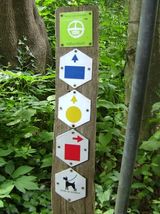
Natuurpunt has a large number of local walking routes all over Flanders. The routes, have one or several information signs - coloured symbols on a white hexagonal plate - with the name of the route, and the signs with arrows have, next to a colour, also a shape, like a rectangle or triangle. In some cases a logo is used, like the "Aardgas" logo.
The routes should be tagged like the other local walking routes above, but should have an additional symbol=* tag, next to colour=*.
This is the list of possible values for the symbol=* tag:
(*) when the route is signed with this logo, you shouldn't use the colour=* tag.
Similarly many routes (e.g. those of the 'Regionale Landschappen') are marked with these signs:
Some examples of names: Oudsberg Rode driehoek, Mechelse Heide Blauwe ruit, ...
(*) The trapezium and boat are not yet supported on Waymarkedtrails.
(**) Only when it is a proper walking route <-> aanlooproute, verbinding
Pilgrim's paths
In Flanders the Compostelagenootschap is currently working out paths for pilgrims going to Santiago de Compostela. More info about the workgroup here. The paths should be signed sometime in 2009.